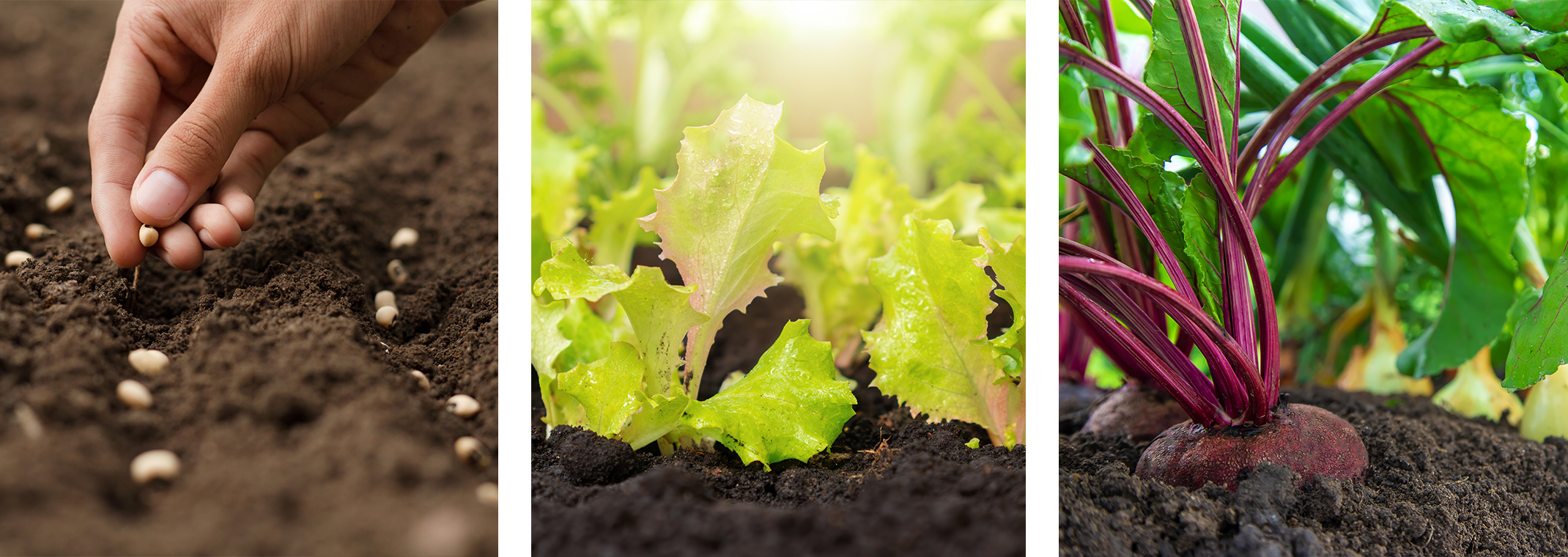 Be Inspired Blog - Arizona
Be Inspired Blog - Arizona

Succession Planting Tips for Arizona’s Low Desert Gardens
Grow More, Longer: Succession Planting in the Valley of the Sun
 One of the biggest advantages to gardening in the the Greater Metro Phoenix area / low desert region is that the “growing window” stretches well beyond what many other climates enjoy. But that doesn’t mean there’s no strategy involved. Succession planting—staggering your plantings so that you always have something maturing in the garden—is a smart way to maximize yield, reduce gaps in production, and keep your beds alive all season long.
One of the biggest advantages to gardening in the the Greater Metro Phoenix area / low desert region is that the “growing window” stretches well beyond what many other climates enjoy. But that doesn’t mean there’s no strategy involved. Succession planting—staggering your plantings so that you always have something maturing in the garden—is a smart way to maximize yield, reduce gaps in production, and keep your beds alive all season long.
In this post, we’ll cover what succession planting is, how to apply it in the Valley, what crops work best, scheduling tips, and pitfalls to watch out for.
What Is Succession Planting (and Why It Matters)
 Succession planting means you don’t plant everything all at once; instead, you stagger plantings or follow one crop with another. That way, as one crop is harvested or finishes, another is ready or nearly ready to take its place. It keeps your garden productive without leaving bare spots that invite weeds. You also spread your harvest instead of getting a sudden glut.
Succession planting means you don’t plant everything all at once; instead, you stagger plantings or follow one crop with another. That way, as one crop is harvested or finishes, another is ready or nearly ready to take its place. It keeps your garden productive without leaving bare spots that invite weeds. You also spread your harvest instead of getting a sudden glut.
In the greater Metro Phoenix area, this matters because our seasons are distinct: hot summers, mild (but drying) winters, and transitional shoulder periods. If you want fresh produce from (roughly) October through May—and sometimes even beyond—succession planting is one of your best tools.
How Succession Planting Works in the Valley (and Low Desert)
 Because we live in a desert environment, our strategy will look different from cool-climate regions. Here are some principles and tips specifically for our area:
Because we live in a desert environment, our strategy will look different from cool-climate regions. Here are some principles and tips specifically for our area:
-
Start with cool-season crops in early fall
As daytime highs dip into the 80s and early 90s, usually in October, you can begin planting your fall/winter garden. Cool-season crops such as lettuce, kale, spinach, radishes, carrots, broccoli and cabbage do well when nights are cooler. October is often described as a perfect planting month for low-elevation Arizona gardens. -
Stagger plantings every 2–3 week
Rather than planting one huge bed of lettuce and having it all ready at once (and then all done), divide your in-ground or raised garden bed into sections and plant each section a week or two apart. That way, when the first section is harvested, the second is still maturing—giving you a continuous supply. -
Follow harvested crops with new ones
As soon as one crop finishes, replant in its spot. For example, when radishes or baby greens are harvested, you might plant a transplant or seed for broccoli or cauliflower, or shorter-season herbs. This keeps soil covered (good for moisture retention, weed control) and maximizes use of space. -
Transition to heat-tolerant crops in late spring / summer
As summer approaches, cool-season crops will struggle. You can stagger plantings of heat-tolerant vegetables—such as okra, eggplant, Armenian cucumber, or sweet potatoes—so they take over the space vacated by spring crops. Many guides for low desert gardening recommend this transitional approach. -
Return to cool-season plantings in fall
As summer wanes, prepare to reintroduce cool-season crops. Start seedlings indoors or in shade, then transplant or sow as the weather cools. This cycle can repeat year to year, giving you a near-continuous harvest.
Which Crops Work Best for Succession in the Valley
 Not every vegetable is ideal for succession planting, especially in our climate. Here are some good choices and strategies:
Not every vegetable is ideal for succession planting, especially in our climate. Here are some good choices and strategies:
Top picks for succession planting in the Valley of the Sun:
-
Leafy greens & salad crops – lettuce, arugula, spinach, Swiss chard, mustard greens
-
Quick roots & radishes – radishes, carrots, beets
-
Brassicas – broccoli, cauliflower, cabbage (via transplants)
-
Herbs & greens – cilantro, dill, parsley
-
Heat-tolerant successions – okra, eggplant, Armenian cucumber, sweet potato, beans
You can also use varietal succession: plant varieties with different days-to-maturity so one finishes earlier and another later. For example, a fast-maturing broccoli variety followed by a later-maturing one can extend your harvest window.
Timing & Example Schedule
 Here’s a sample succession timeline for a fall-to-spring garden in the Phoenix area. (Dates are approximate; adjust for your microclimate, elevation, and weather.)
Here’s a sample succession timeline for a fall-to-spring garden in the Phoenix area. (Dates are approximate; adjust for your microclimate, elevation, and weather.)
-
October (early fall)
-
Plant first round of cool-season crops: lettuce, spinach, radish, kale
-
Plant seedlings of broccoli, cabbage, cauliflower
-
-
October / November (2–3 weeks later)
-
Plant another wave of greens, radishes
-
Replant bed area harvested from early crops
-
-
Late November – December

-
Continue staggered greens / root plantings
-
Begin side-dressing and soil care. Here's how:
-
Spread fertilizer in a shallow band a few inches away from the plant’s base (never directly on the stem or crown, which can burn the plant).
-
Water it in so the nutrients move into the root zone.
-
As the plant grows, its roots will reach the nutrients and take them up.
-
-
-
Late winter → Early spring
-
As night temperatures begin to warm, harvest last of cool-season produce
-
Begin transitioning to warmer-season crops like beans, cucumbers, peppers
-
Use vacated beds for planting heat-tolerant follow-ups
-
-
Spring → Early summer

-
Continue harvesting, replacing with heat-tolerant successions
-
Use shade cloths, mulches, and irrigation adjustments to protect new plants
-
-
Summer → Fall
-
As summer wanes, begin preparing for next cool-season wave
-
Start seeds indoors or in shaded nursery areas
-
Feel free to adjust the spacing of succession plantings (1–3 weeks) depending on how fast your specific variety matures under your microclimate.
Soil, Water & Care Between Successions
 To keep your successions healthy and productive:
To keep your successions healthy and productive:
-
Replenish soil nutrients: After you remove a crop, incorporate compost, worm castings, or organic matter before planting the next crop.
-
Mulch & conserve moisture: Use organic mulch to retain soil moisture, moderate temperatures, and suppress weeds.
-
Adjust watering: As seasons shift, your watering needs change. New seedlings need more frequent moisture; mature plants often benefit from deeper, less frequent watering.
-
Crop rotation & disease control: Don’t plant the same family repeatedly in the same spot. Rotate families to avoid pest and disease buildup.
-
Watch pests & stress: Especially in transitional periods (fall → winter, winter → spring), plants may be more vulnerable. Use shade, row covers, or organic pest controls as needed.
Pitfalls to Watch Out For

-
Planting too many at once – If all your succession plantings mature at the same time, you’ll still end up with a glut and then a lull.
-
Not timing harvests – Keep track of days to maturity and actual harvest dates so you know exactly when to replant.
-
Soil fatigue – Without replenishment, soil loses fertility fast. Amend your soil for the best results.
-
Heat stress on later crops – As spring progresses, older plants may suffer; ensure succession crops can tolerate the rising heat.
-
Sun/shade shifts – The sun’s angle changes through the seasons. Areas that were full sun in fall may shade parts of your garden in winter. Monitor sun exposure.
Putting It Into Practice

-
Map your in-ground and/or raised garden beds and divide them into succession zones (A, B, C).
-
Choose your crops and variety durations.
-
Create a planting calendar or schedule (for example, plant zone A on Oct 1, zone B on Oct 15, zone C on Nov 1).
-
Prepare soil ahead of each planting, and plan for what comes after.
-
Monitor, harvest, rotate, and replant.
-
Keep notes on what worked, what didn’t—micro-conditions in the Valley vary from yard to yard.
 Succession planting is a powerful way to stretch your garden’s productivity, especially in a climate like Phoenix’s that allows for multiple crop cycles in a year. Once you get the rhythm down, you’ll find there’s always something growing, always something to harvest—and far fewer wasted planting windows.
Succession planting is a powerful way to stretch your garden’s productivity, especially in a climate like Phoenix’s that allows for multiple crop cycles in a year. Once you get the rhythm down, you’ll find there’s always something growing, always something to harvest—and far fewer wasted planting windows.
Speak with one our Trusted Garden Advisors or Garden Coaches to learn more!

